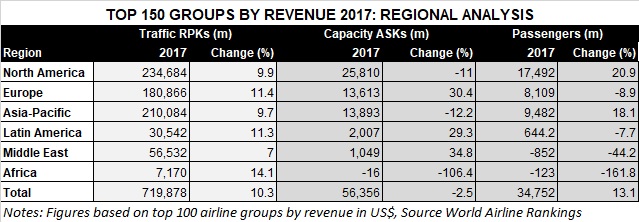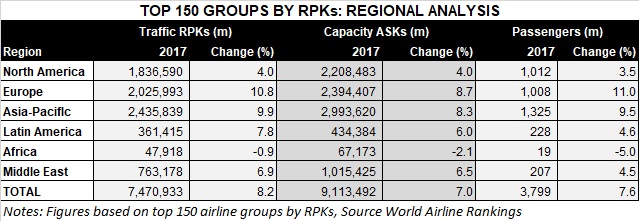While operating profits were, overall, down slightly among the 100 biggest airline groups in 2017, there was the widest-ever spread of those enjoying billion-dollar returns, FlightGlobal's annual World Airline Rankings reveals.
Operating profits across the 100 biggest airline groups by revenue – or the 87 for which figures are available – did, however, slip nearly 3% last year in reaching almost $57 billion.
That largely reflects lower profit levels in the North American market. While the region's carriers remain industry-leading, continuing to deliver almost half of all profits, operating levels were down 11% at just under $26 billion for the year.
But a record 20 airline groups generated operating profits of more than $1 billion in 2017 – two more than in 2016, as Emirates and Turkish Airlines both bounced back. The pair had each generated $1 billion-plus in 2015, before challenges hit them in 2016.

The increased number and spread of groups enjoying operating profits in excess of $1 billion have been a notable feature of the current economic cycle – one which has surpassed previous levels in terms of both profit and longevity.
In 2009, in the grip of the financial crisis, only one airline group generated more than $1 billion in operating profit. Even in 2013, there were just seven airline groups recording that level of return.
Alongside a benign economic environment and the benefits of relatively low oil prices, this also reflects greater consolidation within the industry. Airline groups not only have a larger operation from which to generate profits, but integration has also taken out some of the competition.
Eight of the 20 groups with operating profits of more than $1 billion are from North America – including the four most profitable, in the form of American Airlines, Delta Air Lines, Southwest Airlines and United Airlines. Profits were down at all four, but they still generated combined operating returns of $17 billion.
The fall largely reflected increased costs, notably from labour and fuel. But collective net profit among North American carriers improved during the year, aided by some one-off gains following changes to the tax code last year.
Europe's big-three network carrier groups all generated operating profits in excess of $1 billion. Indeed, one carrier at each of these groups reached that profit level in their own right – Lufthansa, British Airways at IAG, and KLM, which continues to outshine its bigger partner in Air France-KLM.
Ryanair, for all its high-profile operational challenges last year, continues to enjoy an enviable profit record.
Chinese and Japanese carriers lead profitability among the big Asia-Pacific airline groups. Revived Australian group Qantas is the only other operator in the region to have enjoyed an operating profit of more than $1 billion – and for a third successive year.
By contrast, restructuring Cathay Pacific – one of just eight groups to post an operating profit of more than $1 billion in 2010 – slipped to an even deeper loss in 2017.
Gulf carrier Emirates is the only operator among the 20 most profitable to come from outside North America, Europe and Asia-Pacific. Profit rebounded at the operator, in stark contrast to the fortunes of its rival Middle Eastern giants.
Restructuring Etihad Airways disclosed a net loss of $1.5 billion as it suffered a number of one-off hits, notably from its European investments.
Meanwhile, Qatar Airways – which has been forced to restructure its network following the airspace closure by several neighbouring states since last June's escalation of a diplomatic row in the region – has not yet disclosed its financial result for the year.
Africa remains a challenging market. Ethiopian Airlines posted another profit, but South African Airways remains mired in losses and Kenya Airways continues to work through its restructuring.

One of the unheralded returns of last year was the pick-up in air freight. The sector has remained under pressure throughout the cycle. Even as traffic returned, yields continued to struggle.
Yet conditions improved across 2017. Revenues rose more than a quarter among such operators included in the top 100 biggest carriers – including the freight arms of groups that would appear among the largest airlines by revenue in their own right.
Low-cost and leisure carriers continue to play an increasingly prominent role in the industry, accounting for around a sixth of revenues among the top 100 operators.
Southwest is only low-cost carrier to rank among the 10 biggest airline groups by revenue, while three others – Ryanair, JetBlue and EasyJet – figure among the top 30. But low-cost operations comprise an ever-more prominent part of the biggest airline groups, and around half of the 30 biggest airline groups have their own LCC.
The full report is available to download here
Source: Cirium Dashboard



















